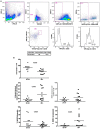Parameters of the Immune System and Vitamin D Levels in Old Individuals
- PMID: 29910802
- PMCID: PMC5992391
- DOI: 10.3389/fimmu.2018.01122
Parameters of the Immune System and Vitamin D Levels in Old Individuals
Abstract
Aim: The increased number of individuals older than 80 years, centenarians, and supercentenarians is not a synonym for healthy aging, since severe infections, hospitalization, and disability are frequently observed. In this context, a possible strategy is to preserve the main characteristics/functions of the immune system with the aim to cause less damage to the organism during the aging process. Vitamin D acts on bone marrow, brain, breast, malignant cells, and immune system and has been recommended as a supplement. We aimed to evaluate whether immune parameters and vitamin D serum levels are correlated.
Methods: We evaluated some features of the immune system using the peripheral blood of individuals older than 80 years (n = 12) compared to young subjects (n = 10). In addition, we correlated these findings with vitamin D serum levels.
Results: Old individuals presented metabolic parameters of healthy aging and maintained preserved some features of immunity such as CD4/CD8 ratio, and low production of pro-inflammatory cytokines after stimulus. On the other hand, we observed increase in the frequency of myeloid-derived suppressor cells, reduction in circulating leukocytes, in the percentage of total CD8+, and in CD8+ Naïve T cells, in addition to increase in the percentage of CD8+ effector memory re-expressing CD45RA (EMRA) T cells. We found seropositivity for CMV in 97.7%, which was correlated with the decrease of CD8+ Naïve T cells and increase in CD8+ EMRA T cells. Vitamin D levels were insufficient in 50% of old individuals and correlated positively with total CD8+ T cells and negatively with CD8+ EMRA T cells.
Conclusion: In the studied population, longevity was correlated to maintenance of some immune parameters. Considering the limitations of the study as size of the sample and lack of functional assays, it was found that vitamin D in old individuals was correlated to some features of the immune system, mainly in the CD8 compartment.
Keywords: T cells; immunity; longevity; myeloid-derived suppressor cells; vitamin D.
Figures







Similar articles
-
The immune system in extreme longevity.Exp Gerontol. 2008 Feb;43(2):61-5. doi: 10.1016/j.exger.2007.06.008. Epub 2007 Jul 4. Exp Gerontol. 2008. PMID: 17870272 Review.
-
Mesenchymal Stem Cells and Myeloid Derived Suppressor Cells: Common Traits in Immune Regulation.J Immunol Res. 2016;2016:7121580. doi: 10.1155/2016/7121580. Epub 2016 Jul 27. J Immunol Res. 2016. PMID: 27529074 Free PMC article. Review.
-
Immune profiles of elderly breast cancer patients are altered by chemotherapy and relate to clinical frailty.Breast Cancer Res. 2017 Feb 28;19(1):20. doi: 10.1186/s13058-017-0813-x. Breast Cancer Res. 2017. PMID: 28241844 Free PMC article.
-
Impact of Aging on the Frequency, Phenotype, and Function of CD161-Expressing T Cells.Front Immunol. 2018 Apr 19;9:752. doi: 10.3389/fimmu.2018.00752. eCollection 2018. Front Immunol. 2018. PMID: 29725326 Free PMC article.
-
The role of the immune system and the biomarker CD3 + CD4 + CD45RA-CD62L- in the pathophysiology of migraine.Sci Rep. 2020 Jul 23;10(1):12277. doi: 10.1038/s41598-020-69285-4. Sci Rep. 2020. PMID: 32704149 Free PMC article.
Cited by
-
Myeloid-Derived Suppressor Cells: Not Only in Tumor Immunity.Front Immunol. 2019 May 15;10:1099. doi: 10.3389/fimmu.2019.01099. eCollection 2019. Front Immunol. 2019. PMID: 31156644 Free PMC article. Review.
-
Polymorphonuclear MDSCs are enriched in the stroma and expanded in metastases of prostate cancer.J Pathol Clin Res. 2020 Jul;6(3):171-177. doi: 10.1002/cjp2.160. Epub 2020 Mar 9. J Pathol Clin Res. 2020. PMID: 32149481 Free PMC article.
-
Increased circulating polymorphonuclear myeloid-derived suppressor cells are associated with prognosis of metastatic castration-resistant prostate cancer.Front Immunol. 2024 Jun 3;15:1372771. doi: 10.3389/fimmu.2024.1372771. eCollection 2024. Front Immunol. 2024. PMID: 38887300 Free PMC article.
-
1α, 25 Dihydroxyvitamin D (1,25(OH)2D) inhibits the T cell suppressive function of myeloid derived suppressor cells (MDSC).J Steroid Biochem Mol Biol. 2020 Apr;198:105557. doi: 10.1016/j.jsbmb.2019.105557. Epub 2019 Nov 26. J Steroid Biochem Mol Biol. 2020. PMID: 31783150 Free PMC article.
-
Functional capacity, renal function and vitamin D in community-dwelling oldest old.Int Urol Nephrol. 2019 Apr;51(4):713-721. doi: 10.1007/s11255-019-02081-w. Epub 2019 Jan 30. Int Urol Nephrol. 2019. PMID: 30701398
References
-
- World Population Ageing 2013. Economic and Social Affairs. New York: United Nations; (2013). 111 p. Available from: http://www.un.org/en/development/desa/population/publications/pdf/ageing... (Accessed: July 21, 2016).
-
- OECD. Health at a Glance 2015: OECD Indicators. Paris: OECD Publishing; (2015). 220 p.10.1787/health_glance-2015-en - DOI
-
- Sahyoun NR, Lentzner H, Hoyert D, Robinson NK. Trends in causes of death among the elderly. Aging Trends (2001):1–10. - PubMed
Publication types
MeSH terms
Substances
LinkOut - more resources
Full Text Sources
Other Literature Sources
Medical
Research Materials

